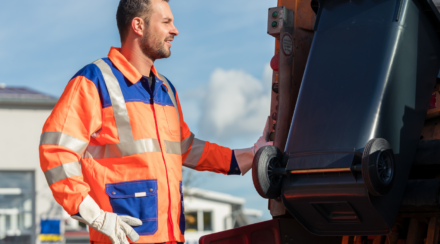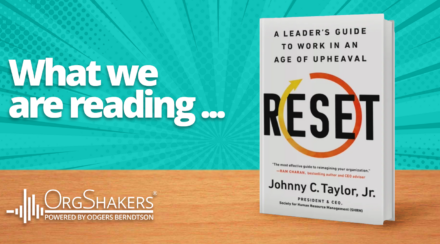Menu

What is the Next Step in the Evolution of the Workplace?
To understand the next step in the evolution of the workplace, we have to start in a place with apparently little or no connection to modern working practices – the middle of the last Ice Age.
Cro-Magnons – the first modern humans – arrived in Europe around 35,000 years ago. Nomadic hunter-gatherers who lived in groups consisting of several families, they were sophisticated toolmakers using spears and flint knives. And, most importantly for our story of workplace evolution, they had sewing needles which they used to fashion clothes from animal skins which kept the ravages of the freezing Ice Age weather at bay.
So, imagine that one dark winter’s night one of our Cro-Magnons hit upon an idea to while away the hours sat round the campfire. They would produce a tapestry on an animal skin – about a yard in width – depicting that year’s key events.
From that point, of course, the yard-a-year tapestry would quickly become an annual tradition with the result that today our 35,000-year-old tapestry would be a few yards short of twenty miles long. So, what would this twenty-mile tapestry show us?
Well, by the time humans even came close to creating the concept of formal work, the tapestry would already be about twelve miles long (which equates to 60% of the history of modern humans). In other words, for the majority of modern human history ‘work’ was simply hunting and gathering – ah, the simple days.
However, after this point, we would begin to see a subtle change in the story on the tapestry. Although hunting and gathering remains the primary means of food production, we begin to see the first indications of animal domestication. This process builds and builds and triggers the Neolithic evolution – which sees the mass shift to agricultural practices and the liberation of the old ways of existence through the creation of trading. Trade, arguably, was the single biggest idea in the history of humankind, as it suddenly allowed for horizons to expand like never before, and people could begin to specialize and innovate in all the ways we now see today.
So, for most of this twenty-mile tapestry, the evolution of the workplace was a very gradual shift over many generations. However, at around the nineteen and three-quatre mile point things began to change and accelerate at a much more rapid pace – the Industrial revolution.
Kickstarted by Jethro Tull’s mechanized seed drill, humans began to invent technology that would enable them to venture away from agriculture and to other new emerging forms of employment. With the need for manual labor in agriculture having been dramatically reduced, workers were given the liberty to pursue a career in something beyond production.
This revolution took the working world by storm – at the dawn of the eighteenth century 76% of the population of England worked in agriculture, but by the mid-twentieth century it was down to just 4%.
And as we began to work in varying jobs, and the labor market expanded and contracted as new innovations and technologies were introduced, that takes us all the way up to today – where technology now plays such a vital role in the mass majority of jobs.
But one thing that we have noticed with the adoption and implementation of mechanization (from conveyor belts to sewing machines to computers) is also this idea that workers are ‘cogs in the mechanism’, and that an ‘optimized’ worker is one who acts like a machine – productive, consistent, and quick. But what happened in those years of technological advancements was that many employers were trying to make people work like machines (sometimes literally, as Ford’s production line proves), when in reality they should’ve been tapping into the key traits that are fundamentally human.
Yet if you look at what is happening now – with the introduction of artificial intelligence (AI) on a mass scale into the workplace – what we are actually seeing is that we’ve come full circle. We are now trying to make the technology human, and I think that AI is going to be the harbinger for this next step of the evolution of the workplace – the step towards the optimization of our humanity.
The overarching purpose of technological advancements in the workplace has always been to free-up time from repetitive, monotonous tasks so that employees can spend more time doing work that creates greater value for both them and their employer. In essence, the entire reason why we have continued to advance is so that we can get to a point where we have the luxury of time to focus on human capital and unlocking its full capabilities.
And we’re already starting to gradually see this shift on our tapestry; the pandemic had a massive impact on the working world, and sparked a re-evaluation of how we work and why we work. We saw a mindset shift amongst the workforce – a carpe diem effect. Suddenly we were all faced with our own mortality, and this made many realise that if they were going to spend a majority of their life working, they wanted to be doing something they cared about, something that gave them a good work life balance, something that supported them, and something fun.
For employers, this means focusing on workplace strategies that will enable better work-life balance (which improves engagement and reduces burnout), opportunities for job crafting (which creates opportunities for innovation), and support for physical and mental health. These areas are going to become key focal points as the workplace continues to evolve to become people-centric, so for those employers who are already beginning to optimize these, they are going to be ahead of the curve and become some of the most attractive organizations to work for in the market.
Steps are already starting to be taken, but they are baby steps. If you look at our recent poll which sought to discover the most effective way of supporting mental health in the workplace, over half of respondents (55%) cited flexible working, while 23% said mental health days, and 16% chose Employee Assistance Programs.
However, while these are great things, they can almost seem tokenistic. Having an allowance of leave for mental health is good, but is this really support? Same as with flexible working; employees can optimize their time better, but now that they are not physically around their team leaders, it’s harder for managers to be more attentive to someone they only see conditionally through a screen.
So, just as we had maintenance teams that would be on-call to fix any machines that malfunctioned, why should employers not consider the same concept for their people? Having an in-house psychotherapist whose sole responsibility is to support employees and feedback to managers with the appropriate reasonable adjustments will help employers create a real roadmap for support and optimization in the face of mental illness. We are already seeing schools begin to hire full-time counsellors and therapists for this very reason, so why should employers not consider doing the same?
As we continue to weave this tapestry of human history year by year, we can see that the last half mile has seen the most accelerated change. Now, as we begin to adapt the ideology of working smart in a technological and AI-advanced world, employers need to be preparing for the next step in the evolution of the workplace by placing their focus on their people power. That is the key to becoming an organization of tomorrow.
If you would like to discuss all things people strategy, our dedicated team of specialized HR professionals can assist you in all aspects – get in touch with us here.



